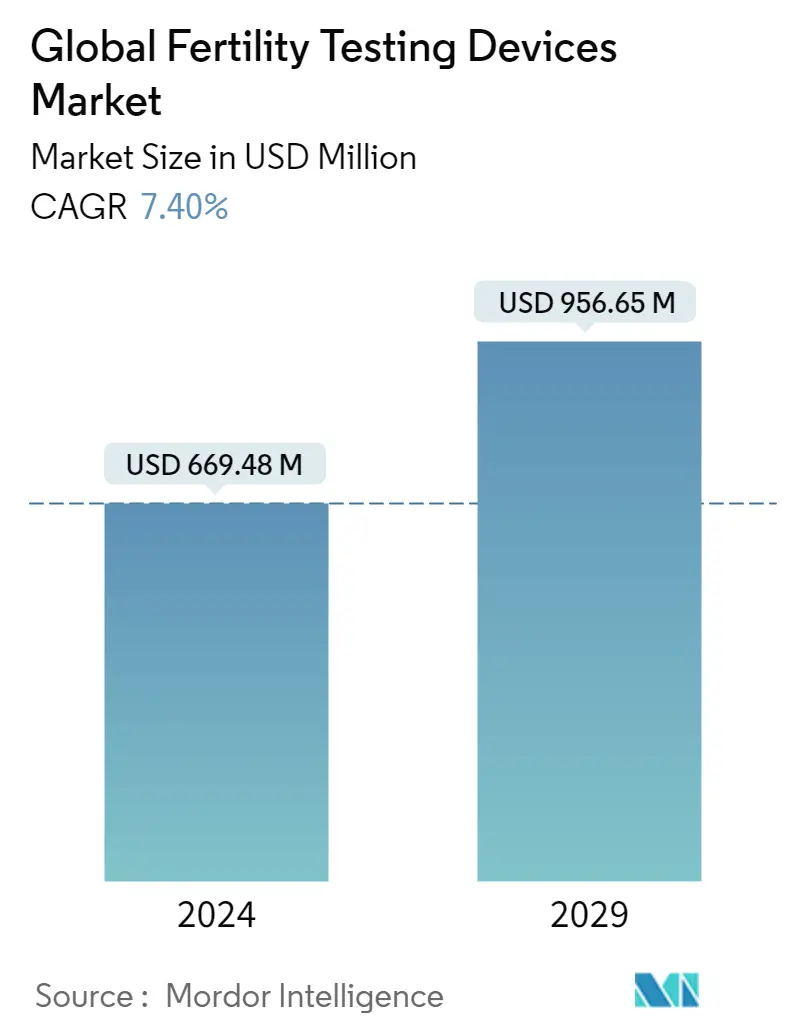Market Size of Global Fertility Testing Devices Industry

| Study Period | 2019 - 2029 |
| Market Size (2024) | USD 669.48 Million |
| Market Size (2029) | USD 956.65 Million |
| CAGR (2024 - 2029) | 7.40 % |
| Fastest Growing Market | Asia Pacific |
| Largest Market | North America |
Major Players
*Disclaimer: Major Players sorted in no particular order |
Fertility Testing Devices Market Analysis
The Global Fertility Testing Devices Market size is estimated at USD 669.48 million in 2024, and is expected to reach USD 956.65 million by 2029, growing at a CAGR of 7.40% during the forecast period (2024-2029).
- The market was negatively impacted by COVID-19 in 2020. Presently the market has now reached pre-pandemic levels. Over the medium term, increasing awareness and favorable government policies and non-government initiatives for curbing air pollution are expected to drive the market's growth.
- On the other hand, the high costs of air quality monitoring systems are expected to hamper the growth of the Asia Pacific air quality monitoring market during the forecast period. Nevertheless, increasing technological advancements in air quality monitoring systems will likely create lucrative growth opportunities for the Asia Pacific air quality monitoring market in the forecast period.
- China dominates the market and is likely to witness the highest CAGR during the forecast period. Increasing awareness of air quality among the public and governments across the country, coupled with supportive government policies.
Fertility Testing Devices Industry Segmentation
Fertility testing is undertaken by both men and women, for the assessment of their fertility and various conditions associated with it. Both men and women experience fertility problems at equal rates, but women are considered to be more concerned about fertility testing. The market is segmented by product type (ovulation prediction kits, fertility monitors (urine-based ovulation kits, saliva-based ovulation kits, and other fertility monitors), and male fertility products), mode of purchase (OTC-based, prescription-based), application (female fertility testing, and male fertility testing), end-user (home care settings, and hospitals/fertility clinics), and geography (North America, Europe, Asia-Pacific, Middle East & Africa, and South America). The market report also covers the estimated market sizes and trends for 17 different countries across major regions, globally. The report offers the value (in USD million) for the above segments.
| By Product | |||||
| Ovulation Prediction Kits | |||||
| |||||
| Male Fertility Testing Products |
| By Mode of Purchase | |
| OTC-based | |
| Prescription-based |
| By Application | |
| Female Fertility Testing | |
| Male Fertility Testing |
| By End User | |
| Home Care Settings | |
| Hospitals/Fertility Clinics |
| Geography | ||||||||
| ||||||||
| ||||||||
| ||||||||
| ||||||||
|
Global Fertility Testing Devices Market Size Summary
The fertility testing devices market is poised for significant growth over the forecast period, driven by increasing awareness and supportive government policies. The market, which experienced a downturn due to the COVID-19 pandemic, has rebounded to pre-pandemic levels. The demand for ovulation prediction kits (OPKs) is particularly rising, as these devices offer cost-effective and accurate fertility testing solutions. The market is characterized by a moderate level of competition, with both local and international companies vying for market share. Companies are focusing on new product launches and technological advancements to maintain their competitive edge. The presence of various types of OPKs, which measure luteinizing hormone levels to predict ovulation, underscores the diverse offerings available to consumers.
The market landscape is further shaped by demographic trends and societal factors, such as declining fertility rates and the impact of economic conditions on family planning decisions. In the United States, for instance, there has been a notable decrease in birth rates, prompting a greater need for fertility testing devices. This trend is mirrored in other regions, where awareness of fertility issues is growing. Despite challenges such as high costs, the market is expected to benefit from technological innovations that create new growth opportunities. The dominance of China in the market, supported by proactive government policies and public awareness campaigns, highlights the regional variations in market dynamics.
Global Fertility Testing Devices Market Size - Table of Contents
-
1. MARKET DYNAMICS
-
1.1 Market Overview
-
1.2 Market Drivers
-
1.2.1 Decreasing Fertility Rates
-
1.2.2 Rising Awareness about Fertility Testing Devices
-
1.2.3 Launch of Advanced, Easy-to-use Fertility Monitors With High Accuracy
-
-
1.3 Market Restraints
-
1.3.1 High Price of Ovulation Monitors
-
1.3.2 Lack of Predictive Accuracy to Confirm Ovulation
-
-
1.4 Porter's Five Forces Analysis
-
1.4.1 Threat of New Entrants
-
1.4.2 Bargaining Power of Buyers/Consumers
-
1.4.3 Bargaining Power of Suppliers
-
1.4.4 Threat of Substitute Products
-
1.4.5 Intensity of Competitive Rivalry
-
-
-
2. MARKET SEGMENTATION
-
2.1 By Product
-
2.1.1 Ovulation Prediction Kits
-
2.1.2 Fertility Monitors
-
2.1.2.1 Urine-based Ovulation Kits
-
2.1.2.2 Saliva-based Ovulation Kits
-
2.1.2.3 Other Fertility Monitors
-
-
2.1.3 Male Fertility Testing Products
-
-
2.2 By Mode of Purchase
-
2.2.1 OTC-based
-
2.2.2 Prescription-based
-
-
2.3 By Application
-
2.3.1 Female Fertility Testing
-
2.3.2 Male Fertility Testing
-
-
2.4 By End User
-
2.4.1 Home Care Settings
-
2.4.2 Hospitals/Fertility Clinics
-
-
2.5 Geography
-
2.5.1 North America
-
2.5.1.1 United States
-
2.5.1.2 Canada
-
2.5.1.3 Mexico
-
-
2.5.2 Europe
-
2.5.2.1 Germany
-
2.5.2.2 United Kingdom
-
2.5.2.3 France
-
2.5.2.4 Italy
-
2.5.2.5 Spain
-
2.5.2.6 Rest of Europe
-
-
2.5.3 Asia-Pacific
-
2.5.3.1 China
-
2.5.3.2 Japan
-
2.5.3.3 India
-
2.5.3.4 Australia
-
2.5.3.5 South Korea
-
2.5.3.6 Rest of Asia-Pacific
-
-
2.5.4 Middle East and Africa
-
2.5.4.1 GCC
-
2.5.4.2 South Africa
-
2.5.4.3 Rest of Middle East and Africa
-
-
2.5.5 South America
-
2.5.5.1 Brazil
-
2.5.5.2 Argentina
-
2.5.5.3 Rest of South America
-
-
-
Global Fertility Testing Devices Market Size FAQs
How big is the Global Fertility Testing Devices Market?
The Global Fertility Testing Devices Market size is expected to reach USD 669.48 million in 2024 and grow at a CAGR of 7.40% to reach USD 956.65 million by 2029.
What is the current Global Fertility Testing Devices Market size?
In 2024, the Global Fertility Testing Devices Market size is expected to reach USD 669.48 million.

